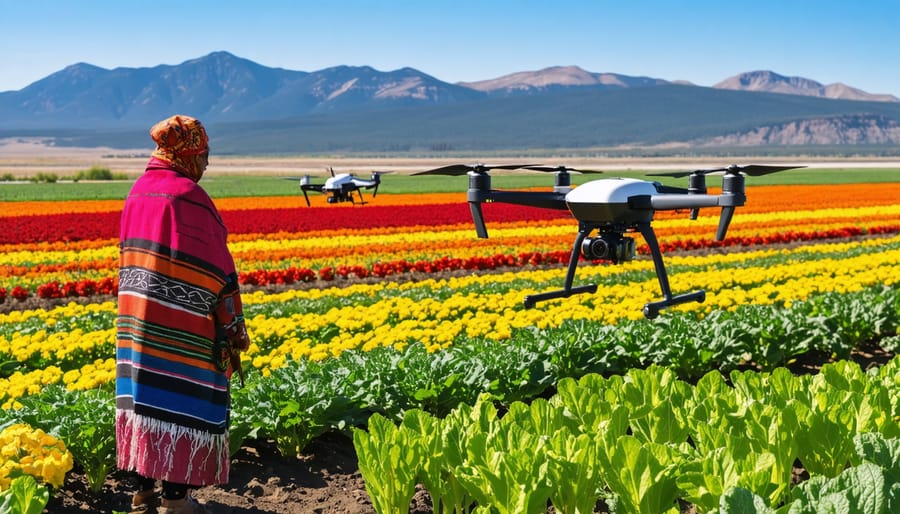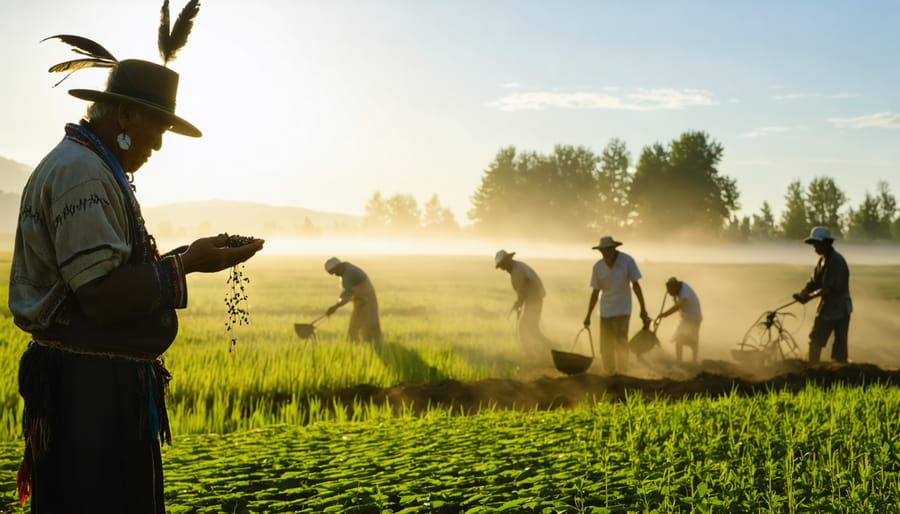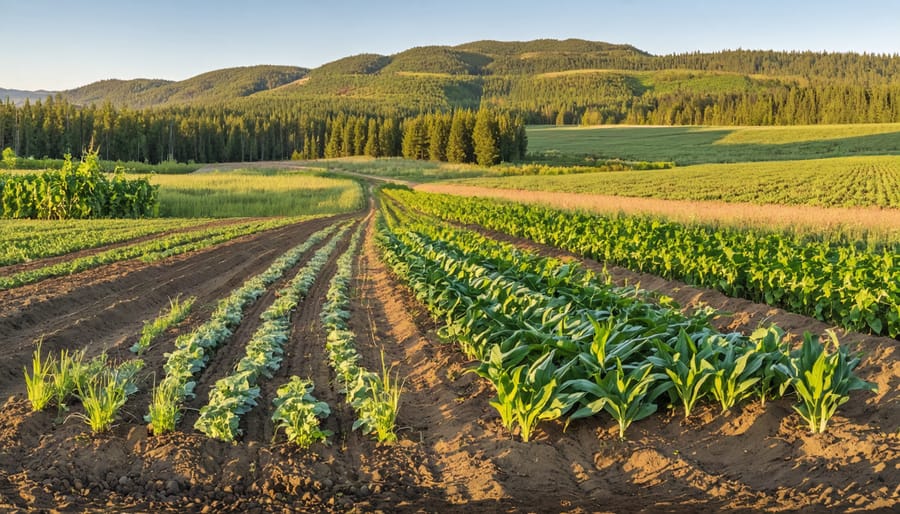Transform your farm into a naturally balanced ecosystem by integrating Indigenous permaculture principles with modern ecological practices. Plant marigolds, nasturtiums, and yarrow strategically between crop rows to repel harmful insects while attracting beneficial predators like ladybugs and parasitic wasps. Establish diverse hedgerows using native Alberta species such as wolfwillow and chokecherry, creating natural barriers that harbor pest-controlling birds and beneficial insects. Rotate crops annually following traditional Three Sisters principles, combining nitrogen-fixing legumes with companion plants that naturally deter specific pest species.
This time-tested approach to pest management has helped Prairie farmers reduce pesticide use by up to 70% while maintaining crop yields. By working with nature’s existing defense mechanisms rather than against them, Canadian farmers are discovering that the most effective pest control strategies often lie in ancient agricultural wisdom. These methods not only protect crops but also build soil health, support local biodiversity, and create resilient farming systems that can withstand changing climate conditions.
Traditional Indigenous Pest Management: A Canadian Heritage

Time-Tested Methods from First Nations Communities
Indigenous communities in Alberta have long practiced effective pest management techniques that work in harmony with local ecosystems. The Blackfoot people traditionally used companion planting, positioning aromatic herbs like sage and sweetgrass around food crops to naturally repel insects. This method remains effective today, particularly for protecting root vegetables and legumes.
The Cree Nation’s practice of timing plantings with moon phases and seasonal indicators helps avoid peak pest periods. They also developed sophisticated traditional water management practices that create healthy soil conditions, making crops naturally more resistant to pests.
Many First Nations communities use controlled burns in early spring to eliminate overwintering insects and their eggs. This technique, when properly timed, effectively reduces pest populations while enriching soil nutrients. The Stoney Nakoda people’s method of incorporating cedar and pine needle mulch around crops serves dual purposes – deterring crawling insects while maintaining soil moisture.
These time-honored techniques demonstrate how working with nature, rather than against it, can provide sustainable solutions for modern farming challenges.
The Science Behind Traditional Practices
Modern scientific research has validated many traditional pest management practices that Indigenous communities and early settlers have used for generations. For example, companion planting works through biochemical interactions between plants – marigolds release natural compounds called alpha-terthienyl that repel harmful nematodes and other soil pests. Similarly, the strong scent of aromatic herbs like sage and lavender masks the chemical signals that pests use to locate their host plants.
The effectiveness of wood ash as a pest deterrent comes from its high alkalinity and sharp crystalline structure, which damages the exoskeletons of soft-bodied insects. Studies conducted at the University of Alberta have shown that wood ash creates an inhospitable environment for slugs and snails, with success rates comparable to commercial products.
Plant-based preparations like stinging nettle tea work through multiple mechanisms – the high nitrogen content strengthens plants’ natural defenses, while the presence of formic acid directly deters many common garden pests. Traditional timing practices for planting and harvesting align with pest lifecycle patterns, demonstrating how generations of observation have led to scientifically sound agricultural practices that remain relevant today.
Natural Pest Control Solutions for Alberta Farms
Companion Planting Strategies
Strategic plant pairing is a cornerstone of natural pest management, drawing inspiration from Indigenous crop rotation methods that have proven effective for generations. Here in Alberta, farmers have found remarkable success with several key plant combinations that naturally deter common agricultural pests.
Marigolds serve as excellent companion plants for vegetable crops, particularly when planted around the perimeter of cabbage and tomato patches. Their strong scent naturally repels cabbage moths and root-knot nematodes. Plant them 30 cm apart for optimal coverage.
Dill and carrots form another powerful partnership. While dill attracts beneficial wasps that prey on carrot rust flies, it should be planted at least 45 cm away from the carrots to prevent competition. Similarly, garlic proves invaluable when interplanted with brassicas, creating a natural barrier against aphids and other soft-bodied insects.
For grain farmers, consider undersowing clover with wheat. This combination not only suppresses weeds but also attracts beneficial insects that prey on wheat midge, a significant concern in our prairie regions. Local success stories include the Morton family farm near Red Deer, where implementing these companion planting strategies reduced pest-related crop losses by 40% over three growing seasons.
Remember to maintain proper spacing between companion plants and rotate combinations annually to prevent soil depletion and pest adaptation.
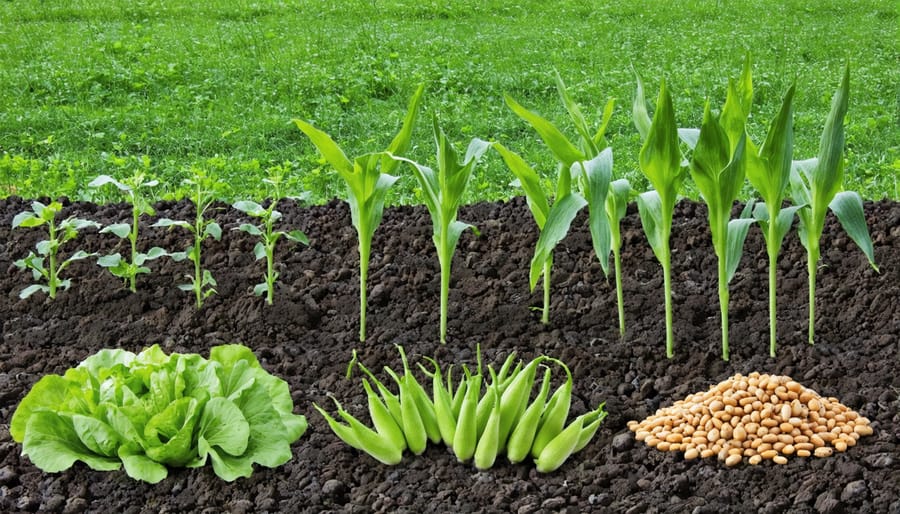
Local Beneficial Insects
Alberta’s ecosystems support a diverse range of beneficial insects that can serve as natural pest control allies on your farm. Lady beetles (ladybugs), particularly the native Seven-spotted Lady Beetle, are voracious aphid consumers, with a single beetle capable of eating up to 5,000 aphids during its lifetime. Ground beetles, commonly found in field margins, help control slugs, cutworms, and other soil-dwelling pests.
Parasitic wasps, including the tiny Trichogramma species, are particularly effective against moth eggs and caterpillars that damage crops. These beneficial wasps are so small they’re often mistaken for gnats, yet they’re powerful pest controllers in vegetable gardens and grain fields.
To attract and retain these helpful insects, maintain diverse habitat areas around your fields. Plant native flowering species like yarrow, golden rod, and aster in field margins or dedicated insectary strips. These plants provide nectar and pollen throughout the growing season, supporting beneficial insect populations even when pest numbers are low.
Creating overwintering sites is equally important. Leave some areas with fallen leaves, standing plant stems, and loose mulch during winter months. Many beneficial insects, including lacewings and native bees, rely on these sheltered spaces to survive Alberta’s harsh winters.
For maximum effectiveness, combine habitat enhancement with reduced tillage practices and careful timing of field operations to protect beneficial insect populations during critical life stages.
Natural Deterrents and Barriers
Creating natural barriers and deterrents is one of the most effective ways to protect your crops without relying on chemical interventions. Many Alberta farmers have found success using companion planting, where strong-scented crops like lavender, marigolds, and dill naturally repel unwanted insects while attracting beneficial ones.
Physical barriers provide reliable protection against various pests. Row covers, made from lightweight fabric, shield young plants from flying insects while allowing sunlight and water to penetrate. Installing cedar or pine wood borders around garden beds naturally deters many crawling insects and slugs, as these woods contain natural repellents.
Living hedgerows of native species like wolfberry and saskatoon create excellent natural barriers that not only block pest movement but also provide habitat for beneficial predatory insects. These hedgerows work particularly well in larger field operations where they can divide different crop sections.
Many Indigenous communities traditionally use crushed eggshells or diatomaceous earth around sensitive plants, creating an abrasive barrier that soft-bodied pests won’t cross. For larger operations, maintaining a three-metre strip of bare soil between fields can significantly reduce pest movement between crops.
These methods are most effective when combined and adapted to your specific situation. Local farmer Jim Peterson from Red Deer notes, “We’ve seen a 60% reduction in pest problems since implementing a combination of companion planting and physical barriers around our vegetable fields.”
Case Study: Success Stories from Alberta Farms
Small-Scale Success: The Thompson Family Farm
Located just outside of Olds, Alberta, the Thompson Family Farm stands as a shining example of successful natural pest management integration. Sarah and Mike Thompson, third-generation farmers, transformed their 40-hectare operation from conventional to organic practices over the past decade, incorporating traditional farming practices alongside modern techniques.
The Thompsons’ approach combines companion planting, beneficial insect attraction, and strategic crop rotation to manage pest populations naturally. Their signature method involves planting strips of flowering herbs like yarrow and chamomile between crop rows, which has reduced aphid infestations by 65% since implementation.
“We noticed immediate results when we started introducing native flowering plants,” says Sarah Thompson. “The ladybugs and lacewings moved in naturally, and our pest problems decreased significantly without any chemical interventions.”
The farm’s success is particularly evident in their canola fields, where they’ve maintained crop yields comparable to conventional farms while eliminating synthetic pesticide use. Their innovative approach includes timing plantings to avoid peak pest periods and maintaining healthy soil biology through compost applications and minimal tillage.
The Thompsons now host monthly workshops for local farmers, sharing their experiences and helping others transition to natural pest management methods. Their success demonstrates that small-scale operations can effectively implement natural pest control while maintaining profitability.
Large-Scale Implementation: Prairie View Organics
Located just outside of Red Deer, Alberta, Prairie View Organics has successfully implemented natural pest management strategies across their 400-hectare operation since 2015. Owner Sarah Thompson transitioned from conventional farming methods after facing increasing pest resistance issues and rising chemical costs.
The farm’s integrated approach combines companion planting, beneficial insect corridors, and strategic crop rotation. Thompson established 3-metre-wide flowering borders around each field section, featuring native plants like yarrow, goldenrod, and prairie coneflower to attract beneficial insects. These natural predators now handle roughly 75% of their pest control needs.
Their most significant success has been in managing wheat stem sawfly populations, a persistent prairie pest. By incorporating solid-stemmed wheat varieties and timing their harvests strategically, they’ve reduced crop damage by 60% compared to previous years.
“The initial setup required careful planning and about $15,000 in infrastructure investments,” Thompson explains, “but our annual pest management costs have decreased by 40% since implementation.” The farm also reports improved soil health and increased biodiversity, with recent surveys identifying 27 beneficial insect species on their land.
Prairie View Organics now serves as a demonstration site for regional farmers interested in natural pest management, hosting regular field days and workshops in partnership with local agricultural organizations. Their success shows that natural pest management can be both environmentally and economically viable at a commercial scale.
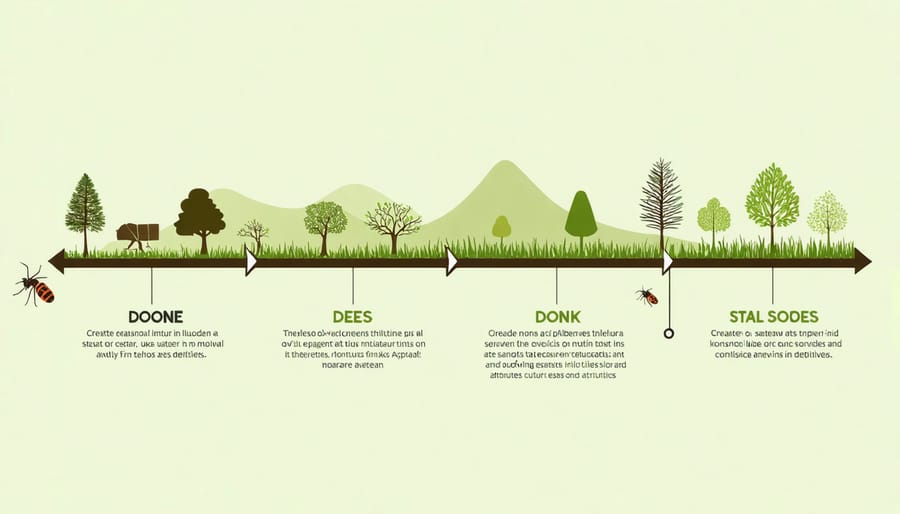
Seasonal Implementation Guide
Spring Preparation
As winter loosens its grip on Alberta’s farmlands, early preparation becomes crucial for effective pest management. Start by conducting a thorough field assessment in early March to identify overwintering pest populations and potential problem areas. Look for signs of vole activity, insect egg masses, and disease symptoms in plant debris.
Create natural barriers by maintaining field edges and encouraging beneficial predators. Install bird boxes for aerial pest control allies like tree swallows and bluebirds, which return to our region in early spring. Consider planting companion flowers like yarrow and goldenrod along field borders to attract beneficial insects as soon as soil temperatures permit.
Many Alberta farmers have success with early-season cover crops like fall rye or winter wheat, which help suppress spring weed emergence naturally. These crops also provide habitat for ground beetles and other beneficial insects that prey on pest species.
Before planting, incorporate well-aged compost to boost soil health and plant resistance to pests. A healthy soil ecosystem supports natural pest suppressors like nematodes and beneficial fungi. Time your plantings strategically – consulting historical pest emergence data for your specific area can help determine optimal seeding dates.
Remember to clean and prepare monitoring tools, including sticky traps and pheromone lures, well before the growing season begins. Setting up a comprehensive monitoring system early allows you to track pest populations and respond promptly with natural interventions when necessary.
Summer and Fall Maintenance
As your crops mature through summer and into fall, maintaining vigilant pest management becomes crucial for protecting your harvest. Regular monitoring remains your best defense – walk your fields at least twice weekly during peak growing season, checking both upper and lower leaf surfaces for signs of pest activity.
Companion planting continues to play a vital role during these seasons. Consider interplanting marigolds, which naturally repel many harmful insects while attracting beneficial ones. Many Alberta farmers have found success with strategic placement of dill and yarrow, which attract predatory wasps that help control caterpillar populations.
Harvest timing can significantly impact pest management success. Consider early morning harvesting when insects are less active, and remove any damaged produce promptly to prevent attracting additional pests. Maintain strong plants by ensuring adequate irrigation during dry spells – stressed plants are more susceptible to pest damage.
As fall approaches, begin your end-of-season cleanup early. Remove plant debris and fallen fruit regularly, as these can harbour overwintering pests. Consider planting cover crops like fall rye or winter wheat to suppress weed growth and provide habitat for beneficial insects that will help next season’s pest management efforts.
Many successful farmers in our region have adopted the practice of leaving strips of flowering plants standing through fall, providing essential resources for beneficial insects preparing for winter dormancy. This approach helps maintain a healthy population of natural pest controllers for the following growing season.
Natural pest management offers a sustainable path forward for Alberta’s farming community, blending time-tested wisdom with modern agricultural needs. By implementing these biological control methods, companion planting strategies, and preventive measures, you can significantly reduce pest pressure while maintaining healthy soil and biodiversity on your farm. The success stories from fellow Alberta farmers demonstrate that natural pest management is both practical and profitable in our unique climate. Remember, transitioning to natural methods doesn’t have to happen all at once – start with a single field or crop variety and expand as you gain confidence. Your local agricultural extension office and experienced organic farmers are valuable resources for guidance and support. Together, we can build a more resilient and sustainable agricultural future for Alberta while preserving our land for generations to come.


